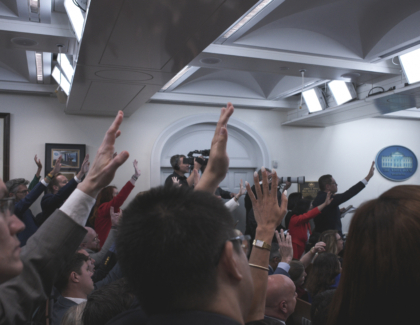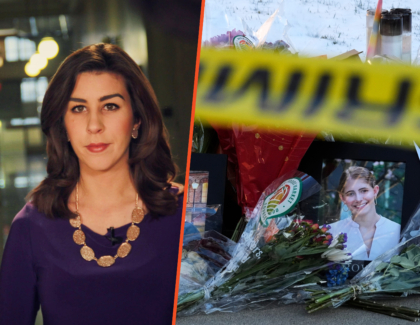Sign up for the daily CJR newsletter.
Hank Morris is done taking questions from the press. Unless they’re about his new musical A Turtle on a Fence Post. (The title of the show, which is currently in previews, comes from an old Bill Clinton quote.)
Morris was a powerful political consultant, until New York’s then-Attorney General Andrew Cuomo prosecuted him for his involvement in a kickback scheme. In the first scene of an early preview version of Morris’s show about his two-year imprisonment, Morris the Character—slight, silver-haired and bespectacled—is surrounded by narrow-eyed journalists. He stands center stage in a blue spotlight, while reporter characters grasping spiral-bound notebooks lean in, barking at him. One wears a bow tie and a pork pie hat.
“I hate questions,” Morris tells them. Then he launches into a song to prove it. “It’s really sometimes the answers that the character doesn’t like,” Morris the Real Man told me, “more than the questions.” But, he added, “I don’t think it’s fun for anyone to be answering the same questions again and again and again.”
Journalists make regular appearances in Morris’s show—more than the ostensible antagonist, Andrew Cuomo, who makes an onstage appearance only once, in a dream sequence (in a brown leather jacket and a khaki baseball cap). On two occasions, four reporters swirl around Hank ominously. One holds a prop digital camera, another a shoulder mounted video cam. A third holds an NBC mic and a fourth clutches a notebook. “We wanna see what happens when you cry,” they sing.
“Look, I don’t think the profession’s monolithic, and I think there are a lot of fantastic people,” Morris says of his disposition toward the press. “But I think there’s a lot of groupthink.” And he believes he’s something of an expert. During the apex of Morris’s career as a political consultant, he says,“I used to talk to twenty of you a day.”
A disclaimer in the playbill reminds the audience that “Turtle… is a fictionalized story inspired by true events.” He doesn’t recant any part of his plea agreement, and if it seems that way, it’s “unintended, disavowed and denied.”
For a narrative squeamish about its own veracity, Morris’s musical reflects his own preoccupation with the truth. To Morris’s mind, truth is rarely fully realized in the news media. He thinks of the New York Times as “the Bible of a news institution.” But he said that when his cousin, a doctor, reads the paper, he finds “things that are just incorrect about science. When he reads an article about the theater or entertainment or politics, he takes it as the gospel. I am not a scientist at all. But I’m a political junkie. Every time I read an article—without exception—there are actual mistakes, let alone mistakes of interpretation. But when I read an article about science in the New York Times, I assume it’s 100 percent correct.”
Unlike the New York Times—or the Bible, for that matter—Morris has the advantage of a sweeping disclaimer. As far as the verifiable truth goes, he doesn’t even have to try to get it right. But he can rake in the viewers with songs, dance numbers, the promise of Cuomo cosplay, and a squishy offer of a la carte truthiness: we can’t promise it’s all true, but some of it is!
Morris’s musical has gotten lots and lots and lots and lots and lots of press. By telling his story with lyrics and lights, Morris has gamed the New York media. His is an unconventional playbook but perhaps replicable for the other publicly reviled white collar criminals of the world: instead of trying to get the New York Times to tell your side of the story, get it to report that you’re telling your side of the story, at this address, at this time, for this price.
“People’s lives aren’t fun narratives,” Austin Nuckols, the musical’s composer, says. “You have to figure out a way to actually sculpt the clay into a nice-looking pot. You can just tell it accurately, like, you have a piece of clay there. And it’s like, well, I mean, that’s clay, sure. But I don’t want to look at it. And getting people to look at it is pretty important.”
On the show’s first night of previews, theater devotee Cliff Bass sat in the front row of the audience, newly returned from a theater-tour trip to London. Reading the playbill’s public statement (titled “Andrew and Me”), Bass, a semi-retired lawyer, told me, “This almost reads like a placard you see at one of those Supreme Court hearings, the sign someone holds outside, on a stick. I was wronged. This is unfair.”
In a scene early in the show, Morris’s phone rings off the hook with calls from Cuomo, which he ignores. The ensemble pleads with him to answer. “Do you really think Cuomo was bothering this guy this many times?” Bass wonders from the audience. “I mean…” (“You could call plenty of people from my political world, and they would answer the question,” Morris says.)
“Hank enraged Andrew Cuomo when he wouldn’t work his campaign,” Morris’s wife’s character says later on. “Do you really think Cuomo tossed this guy in prison because he wouldn’t take his phone calls?” Bass wonders. “I mean…” (“I can’t speak to his motives,” Morris says. “People now know the real Andrew and can judge for themselves whether he’s telling the truth or not.”)
Morris hopes the show brings about two “very specific practical things,”: parole reform, and for the press “to do what they haven’t done ever”—conduct an exhaustive and sober review of Andrew Cuomo’s political career and record.
Beyond that, Morris wants us to know: “Truth is a really hard thing to figure out and to learn. I’m hoping that people realize from this that they should take a hard look at things they think they know for sure.” Morris’s show is not journalism. It’s easier to look at. And it’s easier to swallow, because the audience is given clear permission to leave believing whatever they want.
Has America ever needed a media defender more than now? Help us by joining CJR today.







